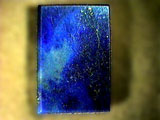![]()
Name:
Lapis Lazuli (Lazurite)

Chem:
(Na,Ca)8(Al,Si)12O24S2
- FeS - CaCO3
Sodium Calcium AluminoSilicate - (with
pyrite&calcite)
Crystal:
Isometric (usually not crystalline, instead aggregate masses)
Color:
blue
Refrac. Index:
1.50
Birefraction:
None
Hardness:
5 - 6
Spec. Grav.:
2.4 - 2.9
Fracture:
conchoidal
Cleavage:
none
Environment:
lazurite is the primary mineral, but lapis lazuli is a physical mixture of calcite, pyrite, lazurite and other minerals to a lesser degree. Found as veins in limestone, and created at the contact metamorphic zone of marbles.
Association:
pyrite, calcite, augite, diopside, hornblende
Locals:
| Afghanistan | Chile | Russia | Calif., USA |
Misc:
The names comes from the Persian "lazuward", meaning "blue". It was the main coloring agent for ultramarine blue pigment, but has now been surpassed by synthetic colorants. It is easily damaged by both acids and strong base.
Gem info:
Lapis has been mined for more than a thousand years as an ornamental stone, and was found in the possessions of Tutankhamen. It is usually cut into cabochons, or geometric shapes. It is also prized for carving. About on par with turquoise and jade in price.
![]()
rectangle
![]()
faceted
![]()
rectangle2
![]()
pyramids